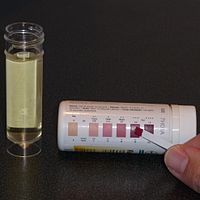
Photo from wikipedia
Oral iron preparations are used as first-line treatment for iron deficiency anemia (IDA), but their gastrointestinal side effects prevent patients from appropriate adherence. We recently conducted a randomized, double-blind, phase… Click to show full abstract
Oral iron preparations are used as first-line treatment for iron deficiency anemia (IDA), but their gastrointestinal side effects prevent patients from appropriate adherence. We recently conducted a randomized, double-blind, phase 3 non-inferiority study to evaluate the efficacy and safety of two dosages of ferric citrate hydrate (FC) compared with sodium ferrous citrate (SF) in patients with IDA. FC at both 500 and 1000 mg/day was non-inferior to SF at 100 mg/day in terms of the change in the hemoglobin concentration at Week 7 from baseline. Logistic regression analysis suggested that the cumulative proportion of patients who achieved the target hemoglobin concentration (≥ 13.0 g/dL in male patients and ≥ 12.0 g/dL in female patients) at Week 7 was highest among those treated with FC at 1000 mg/day, followed by SF at 100 mg/day and FC at 500 mg/day. Both dosages of FC were well tolerated in patients with IDA. The incidences of nausea and vomiting were significantly lower in the FC treatment groups than in the SF group. In conclusion, FC has potential to be an oral iron preparation with sufficient efficacy for the treatment of IDA and a lower risk of nausea and vomiting.
Journal Title: International Journal of Hematology
Year Published: 2021
Link to full text (if available)
Share on Social Media: Sign Up to like & get
recommendations!